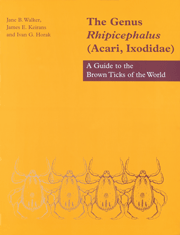Book contents
- Frontmatter
- Contents
- Acknowledgements
- 1 Introduction
- 2 Relationships of the ticks (Ixodida) and definition of the genus Rhipicephalus
- 3 Format for the accounts of individual species
- 4 Glossary
- 5 Rhipicephalus species names of the world
- 6 Rhipicephalus species occurring in the Afrotropical region
- 7 Accounts of individual species occurring in the Afrotropical region. pages 59 to 277
- Accounts of individual species occurring in the Afrotropical region. pages 278 to 490
- 8 Host/parasite list for the Afrotropical Rhipicephalus species
- 9 Rhipicephalus species occurring outside the Afrotropical region
- 10 Accounts of individual species occurring outside the Afrotropical region
- 11 Host/parasite list for the non-Afrotropical Rhipicephalus species
- 12 Species groups based on the immature stages
- 13 The transmission of tick-borne diseases of animals and humans by Rhipicephalus species
- Index
9 - Rhipicephalus species occurring outside the Afrotropical region
Published online by Cambridge University Press: 05 November 2011
- Frontmatter
- Contents
- Acknowledgements
- 1 Introduction
- 2 Relationships of the ticks (Ixodida) and definition of the genus Rhipicephalus
- 3 Format for the accounts of individual species
- 4 Glossary
- 5 Rhipicephalus species names of the world
- 6 Rhipicephalus species occurring in the Afrotropical region
- 7 Accounts of individual species occurring in the Afrotropical region. pages 59 to 277
- Accounts of individual species occurring in the Afrotropical region. pages 278 to 490
- 8 Host/parasite list for the Afrotropical Rhipicephalus species
- 9 Rhipicephalus species occurring outside the Afrotropical region
- 10 Accounts of individual species occurring outside the Afrotropical region
- 11 Host/parasite list for the non-Afrotropical Rhipicephalus species
- 12 Species groups based on the immature stages
- 13 The transmission of tick-borne diseases of animals and humans by Rhipicephalus species
- Index
Summary
HISTORICAL REVIEW
The description of Rhipicephalus sanguineus by Pierre Latreille (1806) early in the nineteenth century was followed much later in the same century by that of R. bursa. This tick, which is common in the Mediterranean region, was collected from a wild boar and described by Professor Giovanni Canestrini and F. Fanzago in an 1878 monograph on Italian Acari. In 1897, also in Italy, Supino described two junior synonyms of R. sanguineus (R. bhamensis and R. flavus. He also described R. haemaphysaloides, an important and widespread ectoparasite of large mammals from Afghanistan and the Indian subcontinent to south-east Asia and Indonesia.
In 1911, Professor V.L. Yakimov and his wife Nina Kol-Yakimova of St. Petersburg, Russia, while working in the laboratory of Professor L.G. Neumann at Toulouse, France, described R. rossicus collected from dogs in the governmental district of Saratov. Two other Russian tick workers each described a single species of Rhipicephalus. Dr. N.O. Olenev, of the Museum of the Russian Academy of Sciences in St. Petersburg, described R. schulzei in 1929 but gave no details of the host or locality. In 1948, Dr. B.I. Pomerantsev of the Zoological Institute of the U.S.S.R. Academy of Sciences produced a description of R. leporis, published posthumously through the assistance of his widow, G. Serdyukova. These specimens were taken from a hare in Uzbekistan. Paul Schulze worked alone in Rostock, Germany, for most of his career. He was essentially an ‘armchair taxonomist’, not visiting the major tick collections or collaborating with other tick taxonomists.
- Type
- Chapter
- Information
- The Genus Rhipicephalus (Acari, Ixodidae)A Guide to the Brown Ticks of the World, pp. 519 - 522Publisher: Cambridge University PressPrint publication year: 2000



